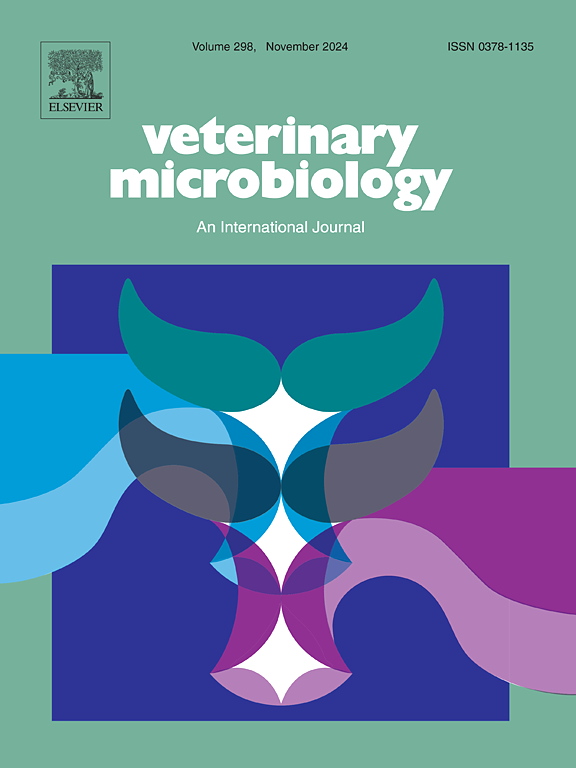Transposon mutagenesis identifies the sspA-sspB operon as essential for serum resistance and virulence in avian pathogenic Escherichia coli
IF 2.4
2区 农林科学
Q3 MICROBIOLOGY
引用次数: 0
Abstract
Avian pathogenic Escherichia coli (APEC) constitutes a significant threat to poultry health worldwide, causing colibacillosis and inflicting substantial economic losses. The ability to resist serum-mediated killing is a key virulence factor enabling APEC to circumvent the host immune system and establish systemic infection. In this study, we employed mariner-based transposon mutagenesis to generate a mutant library of APEC strain E058 and screened for mutants with reduced serum resistance. We identified a transposon insertion within the sspB gene of the sspA-sspB operon that conferred significantly reduced serum resistance. Targeted gene knockout experiments confirmed that both sspA and sspB contribute to serum resistance, with the double mutant (ΔsspAΔsspB) displaying a more pronounced susceptibility to serum compared to the single gene knockouts (ΔsspA and ΔsspB). Furthermore, in vivo challenge experiments in chickens demonstrated that disruption of the sspA-sspB operon significantly attenuated APEC virulence. Our study also reveals that the sspA-sspB operon plays a role in biofilm formation and promotes intracellular survival within macrophages, suggesting a multifaceted contribution to APEC pathogenesis. These findings highlight the sspA-sspB operon as a promising target for the development of novel therapeutics against APEC infections in poultry.
转座子诱变鉴定出sspA-sspB操纵子对禽致病性大肠杆菌的血清抗性和毒力至关重要。
禽致病性大肠杆菌(APEC)对全世界家禽健康构成重大威胁,引起大肠杆菌病并造成重大经济损失。抗血清介导的杀伤能力是一个关键的毒力因素,使APEC能够绕过宿主免疫系统并建立全身性感染。在这项研究中,我们采用基于水手的转座子诱变技术建立了APEC菌株E058的突变文库,并筛选了血清抗性降低的突变体。我们在sspA-sspB操纵子的sspB基因中发现了一个转座子插入,该转座子可显著降低血清抗性。靶向基因敲除实验证实,sspA和sspB都有助于血清耐药,与单基因敲除(ΔsspA和ΔsspB)相比,双突变体(ΔsspAΔsspB)对血清的易感性更明显。此外,鸡体内攻毒实验表明,破坏sspA-sspB操纵子可显著降低APEC毒力。我们的研究还揭示了sspA-sspB操纵子在巨噬细胞内的生物膜形成和促进细胞内存活中发挥作用,这表明APEC发病机制有多方面的贡献。这些发现强调了sspA-sspB操纵子是开发抗家禽APEC感染的新疗法的一个有希望的靶点。
本文章由计算机程序翻译,如有差异,请以英文原文为准。
求助全文
约1分钟内获得全文
求助全文
来源期刊

Veterinary microbiology
农林科学-兽医学
CiteScore
5.90
自引率
6.10%
发文量
221
审稿时长
52 days
期刊介绍:
Veterinary Microbiology is concerned with microbial (bacterial, fungal, viral) diseases of domesticated vertebrate animals (livestock, companion animals, fur-bearing animals, game, poultry, fish) that supply food, other useful products or companionship. In addition, Microbial diseases of wild animals living in captivity, or as members of the feral fauna will also be considered if the infections are of interest because of their interrelation with humans (zoonoses) and/or domestic animals. Studies of antimicrobial resistance are also included, provided that the results represent a substantial advance in knowledge. Authors are strongly encouraged to read - prior to submission - the Editorials (''Scope or cope'' and ''Scope or cope II'') published previously in the journal. The Editors reserve the right to suggest submission to another journal for those papers which they feel would be more appropriate for consideration by that journal.
Original research papers of high quality and novelty on aspects of control, host response, molecular biology, pathogenesis, prevention, and treatment of microbial diseases of animals are published. Papers dealing primarily with immunology, epidemiology, molecular biology and antiviral or microbial agents will only be considered if they demonstrate a clear impact on a disease. Papers focusing solely on diagnostic techniques (such as another PCR protocol or ELISA) will not be published - focus should be on a microorganism and not on a particular technique. Papers only reporting microbial sequences, transcriptomics data, or proteomics data will not be considered unless the results represent a substantial advance in knowledge.
Drug trial papers will be considered if they have general application or significance. Papers on the identification of microorganisms will also be considered, but detailed taxonomic studies do not fall within the scope of the journal. Case reports will not be published, unless they have general application or contain novel aspects. Papers of geographically limited interest, which repeat what had been established elsewhere will not be considered. The readership of the journal is global.
 求助内容:
求助内容: 应助结果提醒方式:
应助结果提醒方式:


